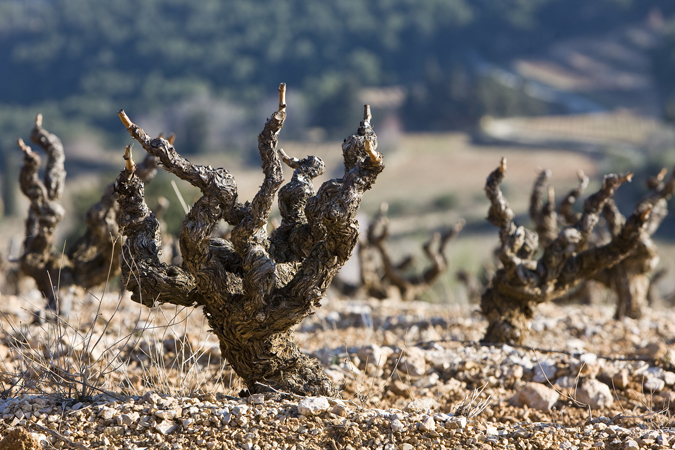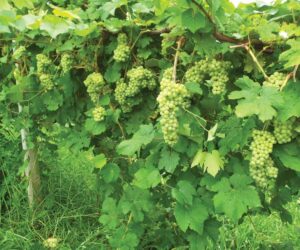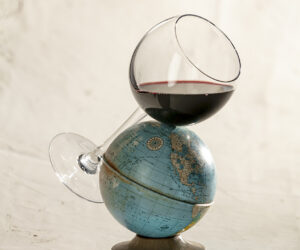
A good winemaker understands not only his or her grapes and where and how they are grown, but also his or her techniques of elaboration and the greater context of the wine he is making. A winemaker will allow the wine to express itself without trying to mold it against its true nature, intervening only to ensure a sound wine of appropriate flavor and character.
In a quest to make Rhône-style wines from kits, we’ll need to do all three of those things to hit our targets. First, we’ll need to survey the offerings of the major kit companies to see how they match up to the styles we’re looking for. Second, since there actually isn’t much grape material offered from the Rhône itself, we have to overlook the place of origin and work our magic in terms of élevage techniques on raw materials we have to express the flavor and character of the Rhône as completely as possible.
What are we looking for in a red?
While there are many hundreds of wineries in the Rhône AOC, classification can be most easily broken into the Northern and Southern wines, with the Syrah-dominated Hermitage, Côte-Rôtie and Cornas leading the charge for full-bodied reds in the north and more medium-bodied wines typified by the Grenache-y Châteauneuf-du-Pape blends in the south.
I’d argue that there should be a third department of the Rhône, made by incorporating the lively, carbonically macerated wines of Beaujolais into the appellation (rather than leaving them in the utterly inappropriate domain of Burgundy) but if you’ve ever tried arguing with the French AOC people in court (I have) it’s like shouting down a well. C’est la guerre.
Syrah of the north
Red offerings from kits include rather a lot of Syrah and Shiraz and every company has at least one or two. For the most part, country-designated warmer-climate Syrah, such as those from California, South America and Australia would be most appropriate: the Northern Rhône, with its steep river valley walls and granite hillsides may not be as baking hot as the flatter valley floor of the south, but that suits Syrah just perfectly: too hot and it turns to bland, alcoholic jam. French Syrah might do just as well, although it’s likely to come from the Languedoc, not the Rhône.
The thing to keep in mind about the wines of the north is that they display good fruit, but (with some exceptions) they are not traditionally “fruit bombs,” expressing more structure and nuance rather than “Cuvee de Jolly Rancher.” As Hugh Johnson and Jancis Robinson said of Rhône wines in The World Atlas of Wine, “The best have depth, length and mature to a lingering harmony comparable to the greatest wines of Bordeaux.” Check with your kit retailer or search the manufacturer’s literature to find a kit that doesn’t sell itself on extreme fruitiness and you can’t go wrong.
Also, while most of these Syrahs spend some aging time in a barrel, they eschew new oak as much as possible and stick to medium-toast, tight-grained French barrels, which deliver structural élevage without conveying gobs of sweet vanilla, cream and toasty-toast to the wine. As with the fruit-bomb idea, there are exceptions: racier winemakers, perhaps forward-thinking, or perhaps just cashing in on the blandly childish palate trends of the late 20th century, have gone to fruitier, riper styles slathered in new oak-wines for millionaires. One hopes they’ll get over it. In the meantime, we’ll be polite and pretend they don’t exist.
Something that will surprise a lot of kit makers is the temperature at which the wines are fermented. Rhône vintners will let the fermentation run between 75–90 °F (25–32 °C). In part, the high temperatures help to extract and fix color from the skins, but also they serve to cook off some of the lighter esters, which while flattening the fruit slightly, allows a more nuanced structure to emerge.
A final twist that winemakers in the north throw in is a squirt of Viognier into their Syrah. The proportion is fairly low in most cases, 2–5%, and although the legally allowable level is 20%, only a few producers go as high as 10%. The Viognier is said to stabilize the Syrah’s color and serves to perfume the wine. It most certainly does add a wonderful frisson of perfume and delicacy underneath the heavier fruit of the Syrah.
This addition should take place post-fermentation, as it’s difficult to judge what will work in a pre-fermentation blend. In the development of a specialty Shiraz-Viognier kit I was involved in recently, all of the formulation was done based on post-fermentation blends and the kits were then assembled from this knowledge. It would have taken ten times longer to formulate the blend by going at it the other way.
Southern reds: Châteauneuf-du-Pape
Châteauneuf-du-Pape is a hot-climate wine, the implication being that the grapes will be very ripe and high enough in sugar to produce rather alcoholic wines. Indeed, the minimum legal strength for Châteauneuf-du-Pape is 12.5%, although in practice few wines come in much less than 14%. If this wine was made from Syrah as in the north it would be incredibly heavy and thick, bombastic and sticky, much like a certain kit wine columnist.
Instead, the dominant grape in the blend is Grenache. A lighter-colored variety, it can be bland and undistinguished in cool climates, or if it’s over-cropped or over-irrigated. However, the southern Rhône affords it long, hot ripening, and while it never develops the inky intensity of Syrah, it can be a deep ruby, with a sweet, almost liquorice-y finish. There’s no percentage set down in law, but only a few 100% Grenache Châteauneuf-du-Pape wines exist. These can be brilliant, but require decades of age to come around and boatloads of cash to purchase. A hint at the probable blend can come from looking at planting percentages in the south: 72% of the total is Grenache, followed by Syrah at 10.5% and Mourvèdre at 7%. The rest goes to the other ten grapes allowed in the blend, none of which you’ll have access to in wine from kits. This turns out not to be a big deal, as most producers in this area don’t bother with them. With Syrah to round out the fruit and Mourvèdre to contribute structure and a hint of earthiness, there’s not a lot missing from the flavor profile.
There aren’t that many 100% Grenache wine kits available (I believe there is only one right now, a “Bush Vine Grenache,” a medal winner and quite good), but there are rather a lot more kits with the wacky name, ‘Vieux Chateau du Roi’. This is the cover name wine kit companies adopted after they lost a lawsuit with the French over origin names applied to kits produced outside of France (who knew they’d be so touchy about copyright?). In the value category these wines tend to be smooth, easy-drinking reds of low-moderate tannin and light-to-medium body. In the higher value market positions they get a lot more sophisticated as they more closely replicate what we’re looking for.
There are a couple of other likely candidates, including Grenache-Syrah and Grenache-Syrah-Mourvèdre blends (how convenient!) available — each has their charms, and as ever, a quick chat with your retailer or a scan of their point of sale material will clue you into the character of the finished product. You’ll do well with any of these choices, keeping in mind that every extra dollar spent on your raw materials will show up in the bottle and the glass, especially as the wine has a chance to age and fully express the character of the grapes.
As with northerly wines, oak is subdued (unless it’s not) and warm fermentations are the norm.
Game plan: a strategy for Rhône reds from kits
Once you’ve chosen a likely candidate kit, make it up according to the day one instructions, complete with any Bentonite additions, grapeskin packs and the appropriate amount of stirring. One thing to delete is the oak. Wine kits have you add the oak on day one to smooth out some green flavors from the grape materials, and to allow the yeast to sequester some of the harsher oak tannins, giving a smoothly rounded oak profile. While oak is subdued in these wines, it’s not common to do barrel fermentations and even with a light hand on the oak throttle, this wine needs post-fermentation oak additions to convey a more straight-up extracted character from the wood. You’ll be adding it to the wine in the carboy after primary fermentation is complete (or rather, you’ll be adding it to the carboy and racking the wine on top of it. If you do it the other way, you could trigger the rapid and complete evolution of carbon dioxide from your wine. (If you don’t know what that looks like, look up “Mentos and Coke” on the Internet.)
One avenue for us to manipulate the outcome of the wine is yeast substitution. The yeast in wine kits has been chosen pretty carefully — normally kit companies do at least thirty trials on any new formulation to determine the best strain to express the character of the wine. However, kit companies don’t work with liquid yeast strains, for two reasons. First, our traditional customer base in Canada hasn’t made them a priority demand. Second, dried wine yeast has had immense amounts of research poured into it, so there are very few disadvantages to using it.
That’s not to say pure liquid cultures may not have a positive effect on your wine. While I can’t endorse a specific variety, the liquid yeast manufacturers all produce very high quality strains — check their literature for guidelines.
When your wine hits the gravity specified for transfer from your primary fermenter to the carboy, containing half the oak that was provided in the kit. You could strike out on your own on this and switch up the oak, possibly substituting a toasted French oak for any light toast American oak will nudge the wine in the right direction, but as a general rule you’ll get pretty fine results by sticking to the oak in the kit but going with half.
After that, your best bet is to extend the process by a few weeks to a few months. You can have a look at my extended kit wine protocols (www.winemakermag.com/component/resource/article/459) for some ideas. Generally the thrust here is to let the wine make itself: aside from keeping it topped up and adjusting the sulfite after a month to hit 25–35 PPM, time is going to be your best winemaking ally here.
Fine your wine according to the extended schedule and allow it to fully clear, filter (or not). At this point you can take your northern Syrah and do some bench trials to see how it is affected by the addition of Viognier. The best way to do this is to pull out ten 100-mL samples of wine in sampling jars (cheap plastic picnic cups work fine for this). Pour one more straight up as a control, and then blend one at 1% (that’s one milliliter — you’ll need a pipette or syringe to pull this off) and go up one mL on every subsequent glass until you hit 10%. Do some sampling to find out where the sweet spot is. Have other folks try your bench samples to confirm your opinion, scale up your results and dose your wine.
If you don’t have a batch of Viognier on hand to use as a blender, 10% of a 6-gallon (23-L) batch of wine is only three 750-mL commercial bottles of wine, and Viognier is pretty commonly available in most areas. Alternatively, you could make more than one blend, or leave a portion of your wine unblended to compare the difference over time. After all, we’re doing this for science, which means lots of extra sampling! At this point you can bottle your wines and leave it for at least six months before you try any. In order for the wine to integrate and express the grapes fully you need to
give it time.
How about whites?
Rhône-style whites are a bit tougher. Viognier, the most famous white of the Rhône is actually in pretty good supply from wine kit companies, but the other two contending whites, Marsanne and Rousanne (usually blended together) are nowhere to be seen. The most famous white wines of this region are from Condrieu in the northern Rhône, and of these, Grillet is the quirkiest and most sought-after. The wines are made exclusively from Viognier. While there are several good examples of Viognier available to kit winemakers, hitting the exact styles of Condrieu can be tricky. First, not many folks will have had this wine: the entire production of Chateau Grillet comes from less than ten acres of vines! Second, none of the Viognier kit makers have access to comes from Condrieu — there’s simply not enough to go around, and they don’t share. That means the Viognier in kit wines, unless it’s of specifically designated origin, could come from Australia, California, Chile, southern France or a half-dozen other places.
While I really like the Viognier available from kits, I’ve never really had one that expressed like Condrieu — not surprising, given the immense price that Rhône Viognier commands — and I’m not sure that any amount of intervention on the part of the winemaker is going to be able to change that with any success. It might just be better to stick to the reds and enjoy kit Viognier for what it is.







